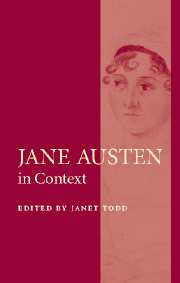19 - Consumer Goods
Published online by Cambridge University Press: 19 December 2020
Summary
Jane Austen grew up in the last quarter of a century that had seen a remarkable expansion of the British market economy. In The Wealth of Nations, published in the year after her birth, Adam Smith examined the relation between wages, production and consumption and, very much in the spirit of the times, advocated the spending of higher incomes and savings in order to perpetuate economic growth. Increasing affluence among the middle classes led to a much greater demand for commodities; and the developments that brought about the Industrial Revolution – availability of raw materials, water power, technical breakthroughs and navigable waterways – enabled it to be met by manufacturers who benefited from conditions that were highly favourable to entrepreneurs. Whilst an important element of this commercial success was a rapid growth in exports, there were still plenty of goods left for the home market; and these were swollen by the large number of imports – more than £12 million worth by 1770 – that the general prosperity made possible. Commodities were brought to Europe from all parts of the globe, and many of them – textiles, sugar, tobacco, for example – gave rise to profitable processing industries; but many were also sold directly to home consumers. Not only tea (expensive at the beginning of the century, less so by the end), coffee, chocolate and spices, but also exotic clothes and furniture were becoming available to the middle classes; and improved transport by means of navigable rivers, canals and turnpike roads, ensured that they were readily obtainable throughout the kingdom. Thus during the reigns of the Georges, particularly that of George III, there was a far wider range of articles of all kinds available for purchase than there had been under the Stuarts; and the average family spent four times as much on them by the end of the century as they had at the beginning.
The fact that things were manufactured does not mean that they were mass-produced, as was to be the case in the nineteenth century: the craftsman was still predominant, and a screen painted at home by an Elinor Dashwood would not have looked very different from a similar item bought in a shop. What is most significant about the furniture and objects in Georgian houses is the progressive change in taste that they reflected.
- Type
- Chapter
- Information
- Jane Austen in Context , pp. 215 - 224Publisher: Cambridge University PressPrint publication year: 2005
- 2
- Cited by



